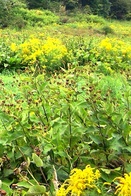 All plants have their place. Some plants, as my mother would hasten to remind me, are outstanding in their field. (Bah-dah-boom!) But burdock. Burdock can go to hell. Towering to six feet in height, and topped with vicious tea-berry-gum clusters of super-sticky, clingy, nasty seed-heads (burs), burdocks can actually kill small birds by dread-locking their feathers into a clump. 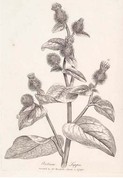 In the autumn, after changing from green to brown, the burs seem to leap into play, tangling hair, burrowing into wool scarves and mittens, forming massive clots in animal fur. Even when carefully plucked out of the a sweater or a mane, the scratchy burs break into smaller and smaller bits, each still clinging tight in a quest to colonize a whole new field in the spring. Of course burdock (family Arctium, sounding all muscular and super-heroic) does have fans. 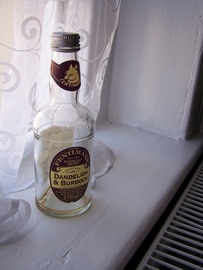 I enjoyed a burdock/dandelion soda in the UK. I enjoyed a burdock/dandelion soda in the UK. Related to thistles, the burdock's amazingly clingy seedhead inspired the hook-and-loop technology of Velcro®. It's also -- to be fair -- edible: the root is a bit like turnip, crunchy and earthy and sweetish. Traditional herbal medicine* uses the plant for skin and hair ailments as well as for purifying the blood and soothing sore throats. (*I go to the source for this: Culpepper's Complete Herbal, published in 1653. Culpepper also recommends burdock as a treatment for rabies, but we'll let that pass.) Still, when I found a stand of burdock at the would-be farm, there was no question of putting the plants to medical use. It was full-on battle-stations. 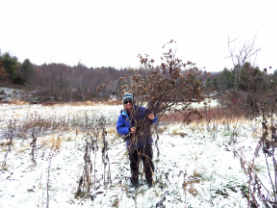 We cleared a way into the patch by breaking off the brittle, woody stems of the plants close to the ground. Working an armful at a time, we gathered giant, hazardous bouquets of burdock and walked them (carefully so that the burs stayed on the branch) straight to the campfire. They snap as they burn. The myriad tiny seedcases crack open as the bur takes on the heat. Each seed releases a tiny bit of oil that flares with a yellow flame, even when the plant is damp from snow. 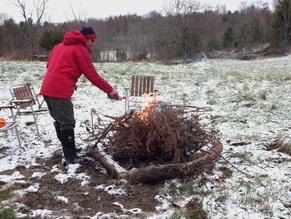 I raked the ashes again and again, and the tiny snapping continued until the coals were gone. No doubt some seeds survived, but maybe we can catch them early this summer. Or put the plant to use. Maybe try this recipe. I suppose the burdock-cull will become part of the annual calendar (knock wood we are granted the years to have such a thing) that puts us next to the fire, trying to flick the burs off our gloves and listening to the crackle as most (but not all) of the seeds turn to ash.
6 Comments
george a.
5/10/2014 05:00:53 am
Old farmer's rule of thumb: One year's weeds equals seven years of weeds. Never ending. You'll win a skirmish or two but not the war. Doesn't mean you shouldn't engage the enemy, just do so knowing that unless you resort to golf club style tactics (aka: Roundup, large scale soil sterilization) the weeds will just laugh and bide their time.
Reply
Amy
5/13/2014 02:03:04 am
Hey George
Reply
George A.
5/13/2014 08:13:38 am
Give 'em hell!
Reply
Amy
5/17/2014 12:24:31 pm
I chopped many of them with a shovel today.
Reply
Lois
5/22/2014 03:24:12 am
I would avoid any recipe that includes this phrase: "While burdock is not difficult to cook, it does require time to manage the thick layer of grit that clings to the surface"...
Reply
Amy
5/30/2014 02:34:43 pm
I hear you, Lois.
Reply
Leave a Reply. |
About the Blog
A lot of ground gets covered on this blog -- from sailboat racing to book suggestions to plain old piffle. FollowTrying to keep track? Follow me on Facebook or Twitter or if you use an aggregator, click the RSS option below.
Old school? Sign up for the newsletter and I'll shoot you a short e-mail when there's something new.
Archives
June 2024
Categories
All
|
 RSS Feed
RSS Feed
